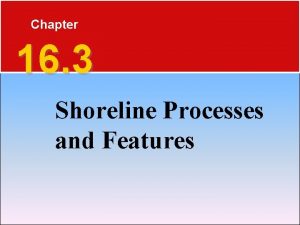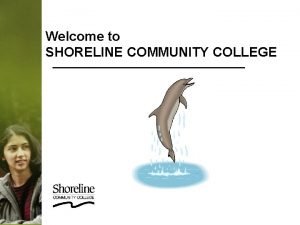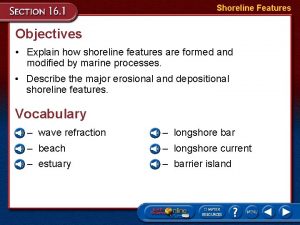Waves and Shoreline Features Chapter 16 2 and











- Slides: 11

Waves and Shoreline Features (Chapter 16. 2 and 16. 3)

16. 2 Waves in the Sea • • Waves are caused by one of 3 ways: 1) underwater earthquakes 2) gravitational pull of moon (tides) 3) most common way is wind

Winds and Waves • Height of a wind-formed wave depends on: 1) wind speed 2) length of time that the wind blows 3) the fetch (length of open water over which the wind blows)

Features of Water Waves • Wave height is the difference between a wave’s crest (high-pt. ) and trough (low-pt. ) • Wavelength is the distance from one crest to the next

Wave Refraction • Explains why an uneven shoreline with shallow water is worn away to a more even shoreline -incoming waves reach a headland 1 st -wave slows down and refracts, striking headland on all sides Refraction – bending of water waves as they reach shallow water

16. 3 Shoreline Features • Ocean waves change the shape of a shoreline by eroding rock materials and by depositing sediments • when waves strike the headlands, they cut away the rock up the high-tide level – Cliffs made of soft materials (soil and clay) wear away faster – In cliffs made of harder rocks: • Notches deepen to become sea caves • Sea caves with broken walls become sea arches • Sea arches that have a broken roof, leave a narrow rock island=sea stack


Sandy Areas • Beach – area of shore between the high-tide level and the low-tide level – Most of the sand on beaches has been deposited by rivers – Sand that is eroded and carried from headlands across the front of bays, may form a sandbar that is attached to the headland on one end. This is called a spit. – If it forms completely across the bay, it becomes a baymouth bar.

Lagoons • Sandbars protect the water behind them from strong winds and waves (these areas are called lagoons) • Lagoons that fill with sediments over time, become salt marshes • Sandbars that are NOT attached to shores, but run parallel to it, are called barrier islands. • Barrier islands, sandbars, and beaches are NOT permanent features


Types of Shorelines • 1) Irregular shoreline- has many inlets and bays • Form when coastal areas are flooded by the sea • Fjords-long, steep-sided bays formed by glaciers • 2) Regular shoreline – is relatively straight – Bordered by sea cliffs and sea stacks
 Shoreline features diagram
Shoreline features diagram Compare and contrast p waves and s waves using venn diagram
Compare and contrast p waves and s waves using venn diagram Do electromagnetic waves require a medium
Do electromagnetic waves require a medium Example mechanical waves
Example mechanical waves What is a rainbow
What is a rainbow What is a semiconductor used for
What is a semiconductor used for Mechanical waves and electromagnetic waves similarities
Mechanical waves and electromagnetic waves similarities Mechanical waves and electromagnetic waves similarities
Mechanical waves and electromagnetic waves similarities Surface waves and body waves
Surface waves and body waves Mechanical waves vs electromagnetic waves venn diagram
Mechanical waves vs electromagnetic waves venn diagram Difference between constructive and destructive waves
Difference between constructive and destructive waves Shoreline cc intranet
Shoreline cc intranet





















